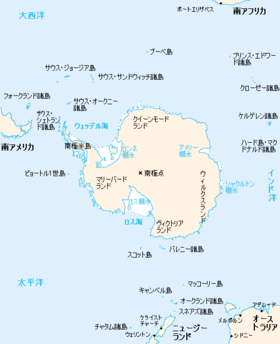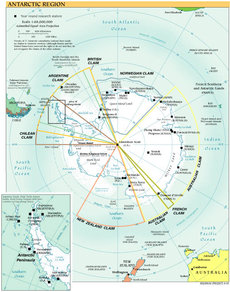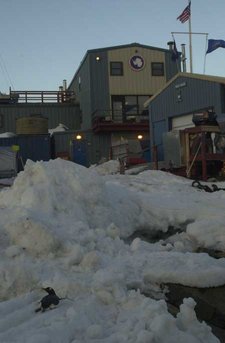Antarctica
|
|
LocationAntarctica.png
Antarctica_satellite_orthographic.jpg
Antarctica (from Greek ἀνταρκτικός, opposite the arctic) is a continent surrounding the Earth's South Pole. It is the coldest place on earth and is almost entirely covered by ice. It is not to be confused with the Arctic, which is located near the Earth's North Pole on the opposite side of the planet.
Although legends and speculation about a Terra Australis ("Southern Land") go back to antiquity, the first commonly accepted sighting of the continent occurred in 1820 and the first verified landing in 1821. A 1513 map by Admiral Piri Reis, however, contains a southern continent that bears a possible resemblance to the Antarctic coast. (See also History of Antarctica.)
With an area of 13,200,000 km², Antarctica is the fifth largest continent, after Eurasia, Africa, North America, and South America. However, it is by far the smallest in population: indeed, it has no permanent population at all. It is also the continent with the highest average altitude, and the lowest average humidity of any continent on Earth, as well as the lowest average temperature.
It has been assigned the Internet ccTLD .aq.
| Contents |
Antarctic climate
Main article: Climate of Antarctica.
Antarctica is the coldest place on earth. Weather fronts rarely penetrate far into the continent, leaving the center cold and dry. There is little precipitation over the continent, but ice there can last for extended time periods. Nearly all of Antarctica is covered by an ice sheet that is, on average, 2.5 kilometers thick.
See-also: sea level rise.
Geography
Main article: Geography of Antarctica
The continent of Antarctica is located mostly south of the Antarctic Circle, surrounded by the Southern Ocean. Physically Antarctica is divided in two by mountains close to the neck between the Ross Sea and the Weddell Sea. The portion of the continent west of the Weddell Sea and east of the Ross Sea is called Western Antarctica and the remainder Eastern Antarctica, since they correspond roughly to the eastern and western hemispheres relative to the Greenwich meridian. Western Antarctica is covered by the West Antarctic Ice Sheet.
See also: Extreme points of Antarctica
Territorial claims
Several nations, particularly those close to the continent, made territorial claims in the 20th century. These claims have little practical relevance due to the Antarctic Treaty which came into effect in 1961, but continue to be observed by cartographers.
Most countries that have observation or study facilities in Antarctica have those facilities within their claimed territory. The Antarctic Treaty defers these claims and most other nations do not recognize them. No other nations have made claims themselves, although the United States and Russia assert the right to do so. All claim areas except Peter I Island (see below) are sectors extending to the South Pole, the borders of which are defined by degrees of longitude. In terms of latitude, the northern border is the 60? S parallel that does not cut through any piece of land, continent or island, which is the northern limit of the Antarctic treaty. The southern border of all sectors collapses in one point, the South Pole.
- Argentina: 25?W to 74?W; overlaps Chilean and British claims; claimed 1943 as AntᲴida Argentina, one of the four departments of Tierra del Fuego - Antarctica & South Atlantic Isles province
- Australia: 160?E to 142?02' E and 136?11' E to 44?38' E; claimed in 1933 as the Australian Antarctic Territory, one of Australia's seven external territories
- Chile: 53?W to 90?W; Overlaps Argentine and British Claims; claimed 1940, as comuna de AntᲴida, one of the two municipalities of AntᲴica Chilena Province
- France: 142?02' E to 136?'11 E; claimed 1924 as Terre Ad鬩e, one of the four districts of the French Southern Territories
- New Zealand: 150?W to 160?E; claimed 1923 as Ross Dependency, as a territory of New Zealand
- Norway: 44?38' E to 20?W; claimed 1938 as Dronning Maud Land, a Norwegian territory
- Norway: Peter I Island at 68?50' S, 90?35'W, claimed 1929, the only Antarctic claim area that is not a sector, a Norwegian territory
- United Kingdom: 20?W to 80?W; overlaps Argentine and Chilean claims; claimed 1908 as British Antarctic Territory, one of the British overseas territories
No formal claims have been made in the sector between 90 degrees west and 150 degrees west, except for the Norwegian claim to Peter I Island (see above).
Historic claims
- Germany: 20?E to 10?W; overlapped Norwegian claim; claimed 1939–1945 as New Schwabenland
- South Africa: claimed 1963–1994

Population
It is usually estimated that at a given time there are at least 1,000 people living in Antarctica. This varies considerably with season. Generally, stations use their home country's time zone, but not always; where known, a base's UTC offset is listed. Antarctica has no permanent residents, but a number of governments maintain permanent research stations on the continent. Many of the stations are staffed around the year. These include:
- Amundsen-Scott South Pole Station, South Pole Template:Flagicon United States Antarctic Program
- Belgrano II, (Template:Coor dm) Laboratory and meteorological station Argentine southernmost base (since 1979). Template:Flag
- Bellingshausen Station, King George Island (Template:Coor dms) Template:Flag
- Bernardo O'Higgins Station, Antarctic Peninsula, Chilean Army. Template:Flag
- Casey, Vincennes Bay (Template:Flagicon Australian Antarctic Division) (UTC+8)
- Comandante Ferraz Station, King George Island (Template:Coor dm) Template:Flag
- Dakshin Gangotri Station, Template:Flagicon Indian Antarctic Program
- Davis, Princess Elizabeth Land (Template:Flagicon Australian Antarctic Division) (UTC+7)
- Dumont d'Urville Station (Template:Coor dm) Template:Flag (UTC+10)
- Eduardo Frei Montalva Station and Villa Las Estrellas, King George Island, Chilean Air Force. Template:Flag
- Esperanza (Template:Coor dm) Laboratory and meteorological station (since 1952). Radio LRA Arcᮧel, School #38 Julio A. Roca (since 1978), tourist facilities. Template:Flag
- General Artigas Station, (Template:Flag)
- Georg von Neumayer Station, (Template:Coor dm) (Atka-Bay) (Alfred Wegener Institute Template:Flag)
- Great Wall Station (Template:Coor dm) (Template:Flag)
- Halley Research Station (Template:Coor dm) Template:Flagicon British Antarctic Survey
- Henryk Arctowski Polish Antarctic Station (Template:Coor dm), King George Island Template:Flag
- Jubany, (Template:Coor dm) (Template:Flag)
- Macquarie Island (Template:Flagicon Australian Antarctic Division)
- Maitri Station, (Template:Coor dm) near Schirmacher Region (Template:Flagicon Indian Antarctic Program)
- Marambio Station, (Template:Coor dm) Seymour-Marambio Island. Laboratory, meteorological station, 1.2Km long, 30 mts. wide landing track (since 1969) (Template:Flag) website (http://www.marambio.aq)
- Mawson Station, Mac Robertson Land (Template:Flagicon Australian Antarctic Division) (UTC+6)
- McMurdo Station, Ross Island (Template:Flag) (UTC+12, follows New Zealand DST)
- Mirny Station (Template:Coor dms) (Template:Flag)
- Mizuho Station (Template:Coor dm) (National Institute of Polar Research Template:Flag)
- Molodezhnaya Station (Template:Coor dms) (Template:Flag)
- Novolazarevskaya Station, Dronning Maud Land (Template:Coor dms) (Template:Flag)
- Orcadas (Template:Coor dm) Orcadas Islands (since 1904)(Template:Flag)
- Palmer Station, Anvers Island (Template:Flag) (UTC-4, follows Chilean DST)
- Progress Station (Template:Coor dms) (Template:Flag)
- Rothera Research Station (Template:Coor dm) Template:Flagicon British Antarctic Survey (UTC-3)
- San Mart�Station (Template:Coor dm) (since 1951) Laboratory and Meteorological measurements (Template:Flag)
- SANAE (South African National Antarctic Expeditions), on the Fimbul Coastal Ice Shelf in Queen Maud Land Template:Flag
- Scott Base, Ross Island (Template:Flag) (UTC+12, follows New Zealand DST)
- Showa Station (Template:Coor dm) (National Institute of Polar Research Template:Flag) (GMT+3)
- Vostok, Antarctica (Template:Coor dm) (Template:Flag) (UTC+6)
- Zhongshan (Sun Yet-Sen) Station (Template:Coor dms) (Template:Flag)
Emilio Marcos Palma was the first person born in Antarctica (Base Esperanza) in 1978, his parents being sent there along with seven other families.
Literature, Cinema, and TV set in Antarctica
- Beryl Bainbridge's The Birthday Boys (1991) (a fictionalised account of the expedition of Robert Falcon Scott)
- H.P. Lovecraft's At the Mountains of Madness (1936)
- Edgar Allan Poe's The Narrative of Arthur Gordon Pym of Nantucket (1838) (though Poe's imagined Antarctica has little in common with the real one)
- Nikos Kazantzakis' epic poem The Odyssey: A Modern Sequel ends with the death of Odysseus in Antarctica.
- Matthew Reilly's Ice Station (1997)
- Kim Stanley Robinson's Antarctica (1997)
- Elizabeth Arthur's "Antarctic Navigation" (1995)
- John Calvin Batchelor's "The Birth of the People's Republic of Antarctica" (1983)
- John W. Campbell Jr.'s Who Goes There? (1938) (the basis for The Thing From Another World (1951) and The Thing (1982))
- Komatsu Sakyo's Day of Resurrection (Japanese title Fukkatsu no Hi)
- Michael Chabon's The Amazing Adventures of Kavalier & Clay (2001)
- Alien vs. Predator (movie) (2004)
- Stargate SG-1 (TV; several episodes) (1997, still running)
- Stargate Atlantis (TV; first episode) (2004, still running)
- Neon Genesis Evangelion (Briefly, though it plays a key r? (1995)
- Michael Crichton's "State Of Fear" (2004)
- Greg Rucka's "Whiteout" and "Whiteout: Melt"
- Nicolas Johnson "Big Dead Place: Inside the strange and menacing world of Antarctica"
Communications
The international dialing code for Antarctica is +672.
Antarctica has wireless telephone services. There is a single cell tower using AMPS technology at Argentina's Marambio Base and an Entel Chile GSM tower on King George Island. Communications are otherwise limited to satellite connections.
Military
The Antarctic Treaty prohibits any measures of a military nature in Antarctica, such as the establishment of military bases and fortifications, the carrying out of military manoeuvers, or the testing of any type of weapon. It permits the use of military personnel or equipment for scientific research or for any other peaceful purposes.
The United States military issues the Antarctica Service Medal to those members of the military who perform research duty on the Antarctica continent.
The only documented large-scale land military maneuver was "Operaci0," undertaken 10 years before the Antarctic Treaty by Argentinian military.
See also
- Climate of Antarctica
- Communications in Antarctica
- Demographics of Antarctica
- Ecology of Antarctica
- Economy of Antarctica
- Flags of Antarctica
- Government of Antarctica
- History of Antarctica
- Sub-antarctic islands
- Transportation in Antarctica
- Mount Erebus disaster
- Diamond dust, an Antarctic optical phenomenon
External links
- ANetStation (http://www.anetstation.com)
- The Antarctic Digital Database - a source of digital topographic map data for Antarctica (http://www.add.scar.org)
- Argentine Antarctic history (http://www.ejercito.mil.ar/antartico/historia/antarti_hist.htm)
- Australian Antarctic Division (http://www.aad.gov.au/)
- British Antarctic Survey (http://www.antarctica.ac.uk)
- Council Of Managers Of National Antarctic Programs (COMNAP) (http://www.comnap.aq/), official homepage.
- German Antarctic Ships and Stations (http://www.awi-bremerhaven.de/Polar/index.html)
- Portals on the World - Antarctica (http://www.loc.gov/rr/international/frd/antarctica/antarctica.html) from the Library of Congress
- The Russian State Museum of Arctic and Antarctic (http://www.polarmuseum.sp.ru/Eng/)
- The Scientific Committee for Antarctic Research - coordinating body for Antarctic Science (http://www.scar.org)
- The World Factbook – Antarctica (http://www.cia.gov/cia/publications/factbook/geos/ay.html) from the U.S. Central Intelligence Agency
Educative External links
- Biodiversity at Ardley Island, South Shetland archipelago, Antarctica (http://www.planetavivo.org/english/ResearchPrograms/Antarctica/SlideShows/ArdleyIsland/ArdleyIsland1.html)
| Continents and regions of the World |
|---|
| Africa | Antarctica | Australia | Eurasia | North America | South America Africa-Eurasia | the Americas | Asia | Europe | Oceania |
| Regions of the world | |
| Africa: | Central Africa | Congo | East Africa | Great Lakes | Guinea | North Africa | Northwest Africa | Northeast Africa | Sahel | Southern Africa | Sub-Saharan Africa | Sudan | West Africa |
| Americas: | Andean States | Caribbean | Central America | Great Lakes | Great Plains | Guianas | Latin America | Southern Cone |
| Asia: | Central Asia | East Asia | East Indies | Far East | Indian subcontinent / South Asia | North Asia | Southeast Asia | Southwest Asia (Middle East, Levant, Anatolia, Arabia) |
| Europe: | Balkans | Baltic region | Benelux | British Isles | Central Europe | Eastern Europe | Northern Europe | Scandinavia | Southern Europe | Western Europe |
| Other: | Eurasia: Caucasus | Post-Soviet states | Oceania: Australasia | Melanesia | Micronesia | Polynesia | Aleutia | Pacific Rim | Polar: Arctic | Antarctic |



